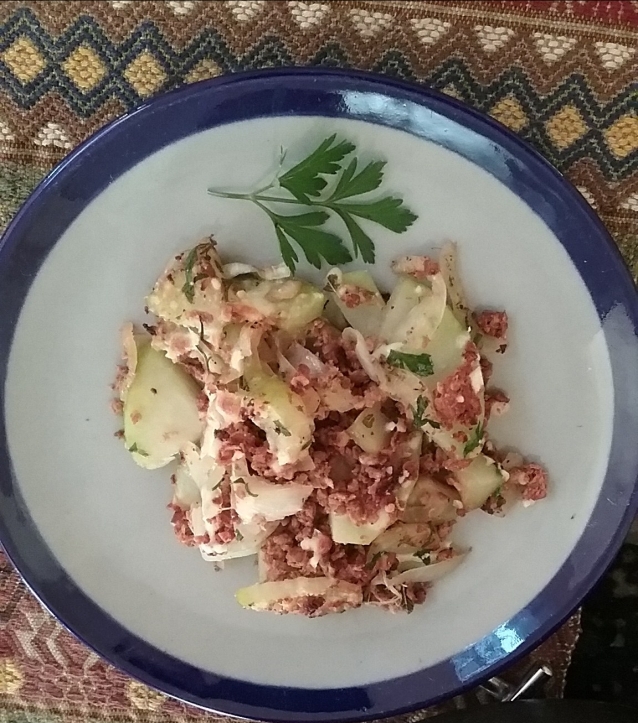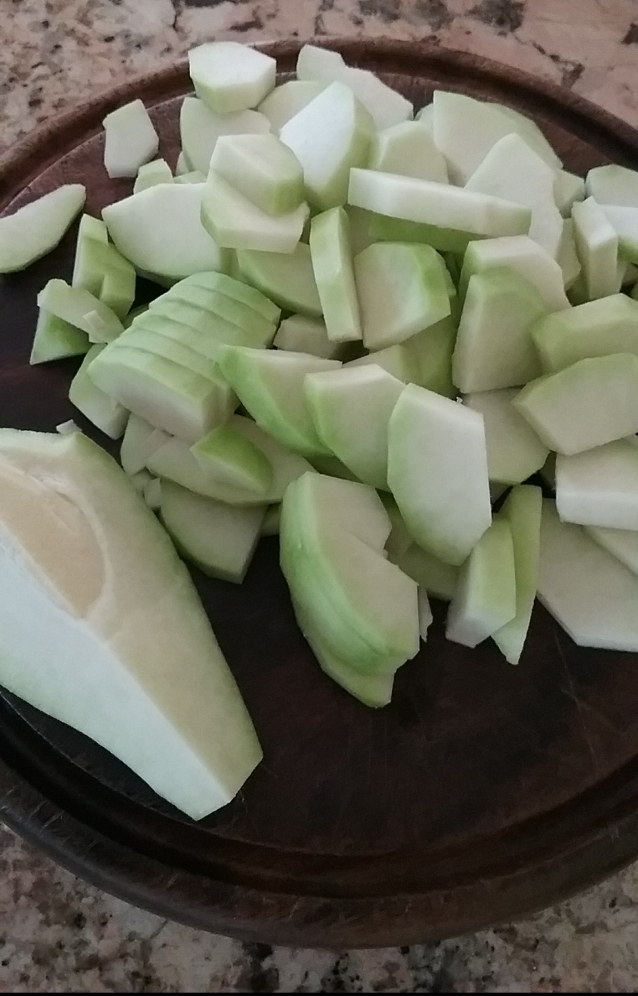Chayote is in season in Mexico. Trellises in local gardens are hanging heavy with this edible gourd, neighbors are giving them away by the dozens (thank you, Lupe), and the fruterias (produce stores) all have piles of green or pale cream colored chayote, smooth or spiney. I prefer the green, smooth variety, though Lupe is generous with her spiney harvest, which requires the use of heavy garden gloves to grasp the gourd without being punctured.
Fruterias sell not only fruit, but almost every vegetable that can be found in Mexico. In fact, fruterias seem to be stocked with more vegetables than fruit. Maybe its just me, but I wonder why they are called fruterias, and not veradurias (vegetable store). That word doesn’t seem to exist in Spanish. This will be my first question if I ever meet a Mexican lexicographer.
There are as many ways to cook chayote as there are to cook zucchini or any other squash. It appears in soups and salads, and fried or stuffed. Chayote is bland on its own and takes well to other seasonings. Chorizo, the uncooked, highly seasoned pork sausage, adds great flavor. Personally, I prefer chicken chorizo, made locally in our little town of Mascota, but pork chorizo would work just as well.
Chayote is between zucchini and winter squash in density, being more firm and taking longer to cook. In the raw state, it really resembles a potato in its hardness.
There are a few wild stories associated with chayote. One involves its regenerative properties, so potent that those who eat a lot of chayote will mummify when deceased. At least that seems to be the case in San Bernardo, Columbia. The other story involves McDonald’s apple pies in Australia, suspected of being made with chayote instead of apples. McDonald’s has debunked this myth, though it is true that chayote was used as a substitute for apples in pies in Australia, because of fruit shortages during the Depression Era and World War II.
Chayote con Chorizo serves 4
- 1/2 large onion, quartered lengthwise, then sliced
- 1 tablespoon plus 1 tablespoon olive oil
- 2 cloves garlic, minced
- 8 oz./228 grams chorizo, removed from casing
- 2 large chayote, about 2 lbs/907 grams, peeled, quartered lengthwise, seed carved out, and sliced 1/4″/.74 cm thick
- 1 teaspoon dried Mexican oregano, or 1 tablespoon fresh, finely minced
- 1/2 cup (118 ml) crema or crème fraîche (or sour cream)
- salt and ground pepper to taste
- 2 oz/57 grams crumbled cotija cheese
- In a large, oven-proof skillet, sauté onion in 1 tablespoon of olive oil until translucent and tender, adding garlic for final 2 minutes of cooking. Remove from pan.
- Saute chayote in 1 tablespoon of oil, adding 2 tablespoons of water and oregano. Cover and steam until tender, about 15-20 minutes, stirring every 5 minutes. Don’t allow to cook until mushy. Remove from pan.
- Cook crumbled chorizo in same pan, adding 1 tablespoon of olive oil if using chicken chorizo. If using pork chorizo, no oil is needed. When cooked, remove from pan.
- Return onion and chayote to pan and mix with chorizo.
- Stir in crema or sour cream. Season with salt and pepper.
- Top with crumbled cotija cheese.
- Broil 6 – 8 minutes, or until cheese is melting and starting to brown.
- Serve hot.
Notes ~
~ In the US, chayote is available at Mexican grocery stores or at large supermarkets. Zucchini or potato can be substituted for chayote. If using zucchini or potato, cooking time will vary.
~ Grated parmesan cheese can be substituted for cotija cheese, also found at Mexican grocery stores or large supermarkets.
~ Top leftovers with a lightly fried egg for a delicious and unusual breakfast.
© 2009-2020 COOKING IN MEXICO ALL RIGHTS RESERVED
All photos and text are copyright protected. Do not copy or reproduce without permission.













